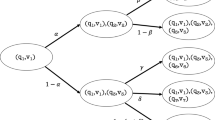Abstract
We continue our study, initiated in [9], of the following computational problem proposed by Nilsson: Several clauses (Boolean functions of several variables) are given, and for each clause the probability that the clause is true is specified. We are asked whether these probabilities are consistent. They are if there is a probability distribution on the truth assignments such that the probability of each clause is the measure of its satisfying set of assignments. Since this is a generalization of the satisfiability problem of predicate calculus, it is immediately NP-hard. In [9] we showed certain restricted cases of the problem to be NP-complete, and used the Ellipsoid Algorithm to show that a certain special case is in P. In this paper we use the Simplex method, column generation techniques, and variable-depth local search to derive an effective heuristic for the general problem. Experiments show that our heuristic performs successfully on instances with many dozens of variables and clauses. We also prove several interesting complexity results that answer open questions in [9] and motivate our approach.
Similar content being viewed by others
References
T. Brun, J. Desrosiers, P. Hansen and H. Jaumard,Proc. Symp. on Mathematical Progress, Tokyo (1988).
G.B. Dantzig,Linear Programming and Extensions (Princeton University Press, 1963).
G.B. Dantzig and P. Wolfe, Decomposition principle for linear programming, Oper. Res. 8 (1960) 101–111.
R. Duda and R. Reboh, AI and decision making: The PROSPECTOR experience, in:AI Applications in Business, ed. W. Reitman (1984) pp. 111–147.
R. Fagin, J. Halpern and N. Megiddo,Proc. IEEE Conf. on Logics in Computer Science (1988).
M.R. Garey and D.S. Johnson,Computers and Intractability: A Guide to the Theory of NP-completeness (Freeman, 1979).
M.R. Garey, D.S. Johnson and L.J. Stockmeyer, Some simplified NP-complete problems, Theor. Comp. Sci. 1 (1976) 237–267.
M. Genesareth and N. Nilsson,Logical Foundations for AI (Morgan Kaufmann, 1987).
G. Georgakopoulos, D. Kavvadias, and C.H. Papadimitriou, Probabilistic satisfiability, J. Complexity (1988).
D. Goldfarb and J.K. Reid, A practicable steepest-edge Simplex algorithm, Math. Progr. 12 (1977) 361–371.
P.L. Hammer, P. Hansen and B. Simeone, Roof duality, complementation, and persistency in quadratic 0-1 optimization, Math. Prog. 28 (1984) 121–155.
D. Kavvadias, Complexity and heuristic methods for probabilistic logic, Ph.D. Dissertation, University of Patras (November 1988) (in Greek).
B.W. Kernighan and S. Lin, An efficient heuristic procedure for partitioning graphs, BSTJ 49 (1970) 291–307.
S. Lin and B.W. Kernighan, An effective heuristic for the traveling salesman problem, Oper. Res. 21 (1973) 498–516.
N. Nilsson, Probabilistic logic, Artificial Intelligence (1986).
C.H. Papadimitriou and K. Steiglitz,Combinatorial Optimization: Algorithms and Complexity (Prentice-Hall, 1983).
B. Rothfarb, H. Frank, D.M. Rosenbaum, K. Steiglitz and D.J. Kleitman, Optimal design of offshore natural-gas pipeline systems, Oper. Res. 18 (1970) 992–1020.
G. Shafer,A Mathematical Theory of Evidence (Princeton, Univ. Press, 1976).
H.E. Shortliffe and B.G. Buneman, A model of inexact reasoning in medicine, Math. Biosci. 3 (1975) 351–379.
L.A. Zadeh, Fuzzy sets, Information and Control 8 (1971) 338–353.
Author information
Authors and Affiliations
Rights and permissions
About this article
Cite this article
Kavvadias, D., Papadimitriou, C.H. A linear programming approach to reasoning about probabilities. Ann Math Artif Intell 1, 189–205 (1990). https://doi.org/10.1007/BF01531078
Published:
Issue Date:
DOI: https://doi.org/10.1007/BF01531078




